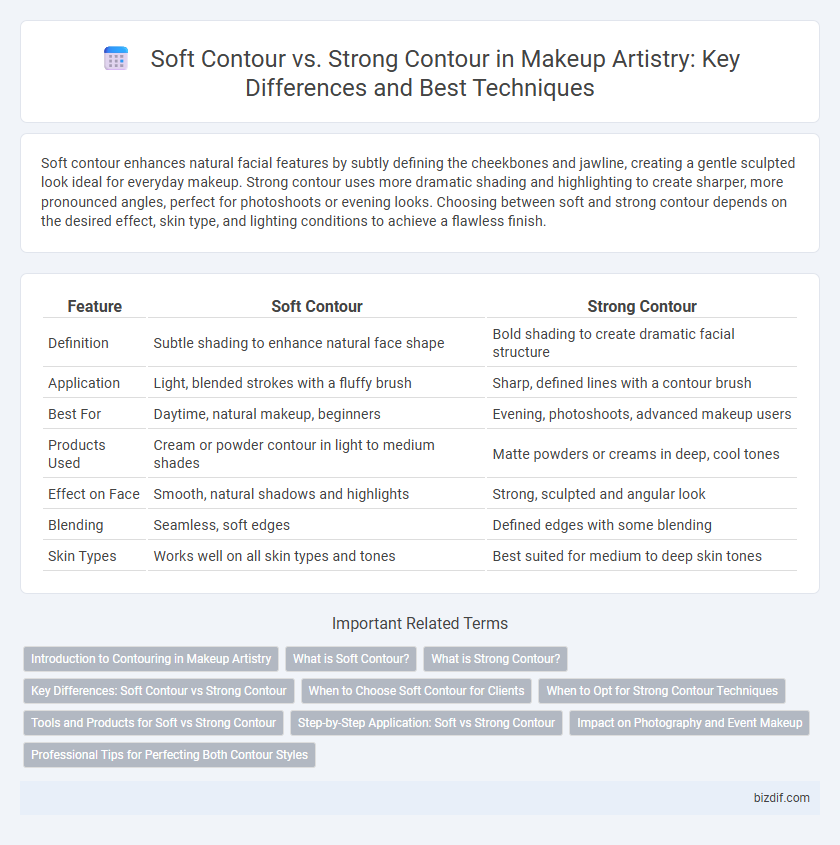Soft contour enhances natural facial features by subtly defining the cheekbones and jawline, creating a gentle sculpted look ideal for everyday makeup. Strong contour uses more dramatic shading and highlighting to create sharper, more pronounced angles, perfect for photoshoots or evening looks. Choosing between soft and strong contour depends on the desired effect, skin type, and lighting conditions to achieve a flawless finish.
Table of Comparison
| Feature | Soft Contour | Strong Contour |
|---|---|---|
| Definition | Subtle shading to enhance natural face shape | Bold shading to create dramatic facial structure |
| Application | Light, blended strokes with a fluffy brush | Sharp, defined lines with a contour brush |
| Best For | Daytime, natural makeup, beginners | Evening, photoshoots, advanced makeup users |
| Products Used | Cream or powder contour in light to medium shades | Matte powders or creams in deep, cool tones |
| Effect on Face | Smooth, natural shadows and highlights | Strong, sculpted and angular look |
| Blending | Seamless, soft edges | Defined edges with some blending |
| Skin Types | Works well on all skin types and tones | Best suited for medium to deep skin tones |
Introduction to Contouring in Makeup Artistry
Contouring in makeup artistry enhances facial structure by using light and shadow to define and sculpt features. Soft contouring creates a natural, subtle dimension ideal for everyday looks, while strong contouring delivers bold, dramatic definition suited for photography or events. Both techniques rely on precise product placement and blending to achieve a seamless finish tailored to skin tone and face shape.
What is Soft Contour?
Soft contour is a makeup technique that enhances facial features subtly by using light, blended shading to create natural-looking shadows. It typically involves using matte bronzers or contour powders applied with a fluffy brush to avoid harsh lines, emphasizing gentle definition rather than dramatic contrast. This technique is ideal for achieving a fresh, radiant complexion while maintaining a soft and seamless finish.
What is Strong Contour?
Strong contour is a makeup technique that uses darker shades to create sharp, defined shadows on the face, enhancing bone structure and adding dramatic dimension. This method emphasizes areas such as the cheekbones, jawline, and nose, making features appear more sculpted and pronounced. Popular in editorial and evening looks, strong contouring requires precise application and blending to avoid harsh lines and achieve a flawless finish.
Key Differences: Soft Contour vs Strong Contour
Soft contour enhances natural facial features with subtle shading and blending, creating a gentle definition that complements everyday makeup looks. Strong contour uses bold, pronounced lines and deeper shades to dramatically sculpt the face, ideal for high-impact or theatrical makeup styles. The key difference lies in intensity and finish: soft contour aims for a seamless, natural effect while strong contour emphasizes sharp contrast and structure.
When to Choose Soft Contour for Clients
Soft contour is ideal for clients seeking a natural, everyday look or those with sensitive skin who prefer minimal layering of products. This technique enhances facial features subtly by blending seamlessly into the skin, making it perfect for daytime events or professional settings. Soft contour is also recommended for mature skin to avoid emphasizing fine lines and wrinkles.
When to Opt for Strong Contour Techniques
Strong contour techniques are ideal for creating dramatic facial definition in high-fashion editorials and evening events where bold makeup is desired. They enhance bone structure by emphasizing shadows and highlights, making features like cheekbones, jawlines, and noses more pronounced under intense lighting. This method is less suitable for everyday wear, as it can appear heavy in natural light and casual settings.
Tools and Products for Soft vs Strong Contour
Soft contour requires lightweight, blendable products such as cream or powder contour sticks and fluffy brushes or sponges to achieve a natural, diffused look. Strong contour demands highly pigmented powders or cream products, often paired with dense, angled brushes or precision makeup tools to create sharp, defined lines. Using the right tools and products enhances the desired contour intensity, ensuring either subtle sculpting or bold facial definition.
Step-by-Step Application: Soft vs Strong Contour
Soft contouring involves applying a light, finely blended shade just beneath the cheekbones, along the jawline, and on the sides of the nose to create natural, subtle shadows that enhance facial features. Strong contouring uses a darker, more defined contour shade, applied with precise brushstrokes to sculpt and emphasize bone structure, often paired with sharper blending techniques to achieve dramatic definition. Each technique requires tailored tools, such as fluffy brushes for soft contour and angled contour brushes for strong contour, ensuring optimal product placement and seamless blending.
Impact on Photography and Event Makeup
Soft contour enhances facial features with subtle shading, creating a natural and flattering look ideal for close-up photography and daytime events. Strong contour uses bold, defined lines to sculpt the face dramatically, making features pop under bright lights and high-definition camera lenses, perfect for theatrical or evening makeup. Choosing between soft and strong contour depends on the event's lighting, camera quality, and desired visual impact to achieve the best photographic results.
Professional Tips for Perfecting Both Contour Styles
Soft contour enhances natural facial features by blending seamlessly with foundation, using light, neutral-toned powders or creams to create subtle shadows that sculpt the face without harsh lines. Strong contour employs deeper, more pigmented products applied with precision to sharply define cheekbones, jawline, and nose, often paired with highlighting to maximize contrast and dimension. Professional tips include selecting contour shades two to three tones darker than the skin, blending with damp beauty sponges or dense brushes for softness, and customizing intensity based on lighting and event type for flawless finish.
Soft contour vs Strong contour Infographic

 bizdif.com
bizdif.com